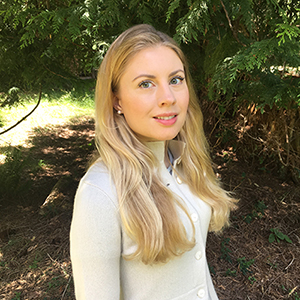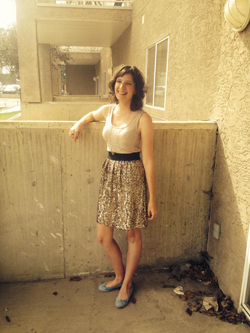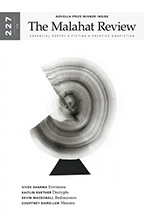Using the Rubrics: Rose Morris in Conversation with Emily Osborne

Malahat volunteer Rose Morris talks with 2018 Far Horizons Poetry Award winner, Emily Osborne, whose poem "Venn diagrams" was chosen for the $1,000 prize.
The contest judge Carolyn Smart had high praises for Osborne's poem: "My final decision was for 'Venn diagrams,' which held my attention fully over a month of intense readings. I found new entry points to it each time, understood more, was baffled and surprised more each time I read it."
Emily Osborne's poetry has appeared in CV2, The Literary Review of Canada, The Eyewear Review, Canthius, and elsewhere. Her chapbook Biometrical is forthcoming from Anstruther Press. She earned a PhD in Old-Norse Icelandic literature from the University of Cambridge. Her full-length book of verse translations will be published in 2019.
See the original 2018 Far Horizons Award for Poetry winner announcement page.
What made you enter the Far Horizons contest and what does winning mean to you?
Winning the Far Horizons contest is a significant event for me because poetry has been a focus of much of my life. I began writing poetry and stories in kindergarten, and wrote profusely as a child, teen, and young adult. During my Master’s degree and PhD (which focused on Old English and Old Norse poetics) I found it difficult to write my own poetry because so much of my mental space for verse was spent on research, translation, and teaching. In late 2016, I made the difficult decision to step away from academia for now, and do more flexible work (contract research, editing, and translation) so that I could concentrate on my poetry. It was a huge help that my husband, Daniel Cowper, is also a poet and very supportive, but this career change was still fraught with uncertainty. Winning the Far Horizons contest has felt like a validation of the risk I took in focusing on poetry.
When I began submitting to journals in Spring 2017, several writers suggested that contest deadlines provided motivation to polish work. Since last year I have submitted to several contests run by journals I look forward to reading and wish to support. Considering that an entry to the Far Horizons Contest purchases poets a one-year subscription to The Malahat Review, I saw no downside to entering!
In several contests I have made a long-list or been a runner-up, but Far Horizons is the first I have won. I would like to express gratitude to The Malahat Review volunteers, editors, and staff for their time in reading the poems and selecting “Venn diagrams” as a finalist. I am also extremely grateful to judge Carolyn Smart for selecting my poem as the winner. I admire the scope and empathy of Smart’s poetry, which made it all the more wonderful that she appreciated my poem!
Your winning poem, “Venn diagrams,” is extremely sensuous in nature. How are the senses important in your piece or, if you like, in literature in general?
Poetry has always been one of our most embodied art forms. For thousands of years poetry preserved individual and collective memory or story by being internalized and passed on. Rhythm and sound consonance/dissonance helped poetry stick in the mind and roll off the tongue; most people reading this will be able to “hear” Dylan Thomas’ “Do Not Go Gentle into that Good Night” because of its string of stressed syllables. While we no longer need to memorize poetry or perform it aloud to circulate it, people still respond strongly to poetry that maintains a sense of being close to the body through discernable sound patterns, fluid or forcible rhythms, or through descriptions of embodied, kinetic and sensory experience. Here I think of Rossetti’s “Goblin Market” or Amy Clampitt’s “Gooseberry Fool” or “Balms.”
At another level, most of our experiences involve multiple senses: shifting scents and sounds, air temperature on the skin, an object’s tactility. Invoking multiple senses in poetry gives authenticity and immediacy to a reader’s experience, especially where the subjects described in a poem are alien to the reader.
The complexity of sensory awareness and memory becomes one of the dominant conceits of “Venn diagrams.” What begins as a school lesson in Venn diagrams, in which children categorize foods by flavours, suffuses other aspects of a child’s day. How senses overlap and become intertwined with our early memories is difficult to understand. Children are bombarded with new sensations, such as the bright clothing and zingy candies marketed to them. How did the taste of a sandwich mingle with the feeling of eating alone? How does our memory of that taste affect the memory of loneliness?
When I think back on a single school day, so many discordant activities and emotions were jammed together. The child in this poem cycles through class subjects, bullying, anxiety, a memory of abuse, financial concerns at home, and religious ritual. All of these events produce “flavours” or sensations on the tongue. Some of these flavours are easily identifiable, some bleed into others, and some cannot be understood or categorized using the rubrics the child has for lessons, games, or prayers.
How do you feel the form of your poem affects the piece as a whole?
The poem uses multiple forms: chronological, circular, and overlapping. It combines the chronology of a child’s regulated day from morning lesson to bedtime prayers, with the circularities of a Venn diagram and the overlapping of concepts or experiences within that diagrammatic frame. A Venn diagram is a disarming organizing principle. It presents values or characteristics of disparate things both in distinction and in relation, but without causation or explanation of why this is so.
The poem maintains some visual properties of a Venn diagram, as if the framework itself has been removed. I hope the poem’s form has both a fluid and disarming quality, even as a child is guided through segments of their day while being jarred by structures and thoughts they cannot explain or express. The adult reader who sees the child moving through this Venn diagram perceives more clearly how events relate; for example, how a child’s situation at lessons and lunch hour compares with a mother’s posture at family dinner.
I was struck by how you managed to integrate an excess of imagery throughout the poem, without allowing one image to overwhelm another. How did you achieve this sense of cohesive flow while still loading every line with a great deal of imagery?
Children feel things so deeply, but often don’t have time to sort out their feelings because they are forced to move on to new activities. Recess is a whirlwind in my memory, where I witnessed or experienced bullying and then was caught up in games, some of which (like tag) could change suddenly from fun to frightening. The range of imagery I employed in the poem’s nine vignettes was intended to capture both the heightened responses children have and this shuttling from one activity to the next. A skill that I think writers are always re-learning is when an image has run its course and it’s time to move on; I know I struggle with this! Perhaps the form I chose for “Venn diagrams” made these editorial decisions a little easier.
Many poems that incorporate a range of imagery or topics but which still feel cohesive to me often return to one or two dominant conceits. In this poem I also tried to create cohesion through various circling effects (in the child’s motions, in images, in sounds). An underappreciated but effective technique in poetry, I think, is to incorporate harmonious sounds where a jarring image or transition appears. Poetry is such a compelling instrument for making the familiar strange and the strange familiar. Aural cohesion provides a link between divergent concepts, making the strange feel familiar to what we’ve heard before.
I love the way you intermingle science, religion, and the body in “Venn diagrams.” Was that intentional? Do you think of these three things as disparate or related? Or both?
There is biochemical language in the poem that is beyond the reach of the child. At a biochemical level, I think there are some interesting interrelations among science, religion, and the body. One thing that comes to mind is how both science and religion consider how our physiological responses to sensory data motivates our behaviour. While science might ask how taste drives us to eat certain foods and avoid others, religion might ask how sensual pleasures drive us to a spirit of excess. Conversely, a pleasant smell might encourage people to participate in an activity, such as prayer or buying a product. This is a huge topic, of course. But I wonder where children fit into this paradigm, because of their naturally curious nature. In “Venn diagrams”, the child tastes non-food objects. I remember as a very young child being curious how non-food items tasted (presumably I wasn’t the only one!). By a certain point I learned that it is unwise to do this.
What writing projects are you working on currently?
There are several projects I’m excited about! My chapbook, Biometrical, is in its final stage of edits and will be published by Anstruther Press this Autumn. It’s been a great experience working with Jim Johnstone and Blair Trewartha in putting together a collection. Recently I’ve begun thinking about my first full collection, since I have enough material I’m happy with. Daniel and I are also writing collaborative poems where we alternate lines; maybe someday we will gather the best ones into a small collection.
The other larger project I’m working on now is called Quarrel of Arrows, a full-length book of translations of Old Norse-Icelandic skaldic poetry that will be coming out next year with Junction Books. The book will contain my translations of ten Norwegian and Icelandic poets who lived between the ninth and fourteenth centuries.

Rose Morris
* * * * * * * *









